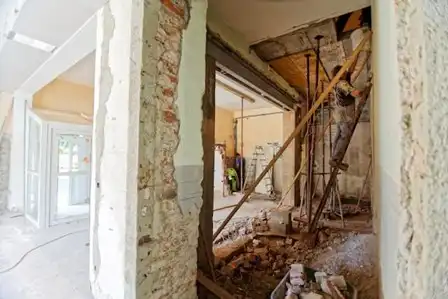Home renovation perfect layout planning, House transforming space, Property renewal refurb design
Planning the Perfect Layout for Your Home Renovation
19 December 2024

Photo by Milivoj Kuhar on Unsplash
With house prices rising, renovating an existing home offers a fantastic way to achieve that fresh, new-home feeling while staying within a manageable budget. It’s an opportunity to transform a space into something truly unique and personal, without the financial strain of purchasing a new property.
Planning a home renovation can sometimes feel overwhelming, especially with the many stages involved and the time it may take. However, staying focused on the end result helps keep motivation high. The effort invested will be well worth it when the result is a home perfectly tailored to your needs and style.
This post has been created to walk through the essential steps to support the renovation process. It covers key considerations like organization, budgeting, and even integrating security features to ensure the process runs as smoothly as possible. With careful planning and the right approach, creating your dream home can feel achievable and rewarding.
Collaborate with a Home Renovation Team
When homeowners without expertise as general contractors, architects, or engineers take on home improvement projects themselves, mistakes can become expensive. A full-scale home remodel is a massive undertaking with many potential challenges. Tackling it alone means facing complicated issues without the knowledge, experience, or network to handle them effectively.
A residential renovation team can save you time, money, and stress. Partnering with a professional firm like Arch Exteriors Home Improvement can help you avoid the costly, and sometimes unsafe, errors that often occur with DIY renovations. A dedicated renovation team will work with you to establish a realistic budget, map out a timeline, and clarify where to begin, even if your project will be completed in stages.
Beyond just assisting with the planning, your renovation team will oversee the entire process on your behalf. From the initial consultation to the final installation, they manage every aspect of the project. This includes applying for permits, scheduling inspections, hiring qualified contractors, and navigating specific requirements like historic planning commissions if needed. They’ll also coordinate the delivery and installation of all materials, fixtures, and furnishings, ensuring every detail is handled precisely.
Plan Your Budget
It is essential to highlight your budget in the brief. Even without knowing the exact building costs, establishing clear limits on how much can and cannot be spent is crucial. If the project involves selling the property or planning to stay long-term, it becomes important to evaluate the house’s value and decide whether to under-capitalize or over-capitalize the property.
Budget blow-outs are a common challenge during renovations, often caused by skipping the concept stage. Attempting to quote a project without a clear design or concept leads to significant cost variability. Starting with concepts helps establish an early understanding of the project’s potential costs and ensures financial feasibility.
Moving on to working drawings offers a detailed breakdown of components, resulting in a well-resolved cost estimate. This thorough process aids in keeping the project on budget. Contingency planning is also vital due to the unpredictability of renovation projects. Issues like leaks, rotting, or subsidence often arise after work begins, making it critical to allocate funds to address such unforeseen problems.
Establish Your Project Schedule
With your budget set and your team ready, the next step is to create a timeline for the project. This will serve as a roadmap for the tasks ahead, though the final schedule will ultimately hinge on your contractor’s availability.
To determine a start date, work backward from your desired completion date. Meet with your contractor to map out how long each phase of the project will take and to identify the order in which tasks need to be done. Structural work, such as roof or foundation repairs or electrical upgrades, should be tackled first.
Don’t forget to account for the weather. Plan outdoor tasks for days with favorable forecasts, and consider factors like temporarily turning off heating or air conditioning on days when electrical work is required.
Invest in high-quality, Eco-friendly Materials
When planning your dream home renovation, prioritize investing in the highest quality materials within your budget. Not only do they offer greater durability, but they also enhance the overall value of your property.
Consider the environmental impact of your choices by selecting sustainable options like composite decking that promises longevity, and incorporating energy-efficient solutions such as improved insulation to maximize your investment.
Quality materials don’t have to mean splurging on brand-new items either, salvage yards are treasure troves for second-hand timber, bricks, doors, and fittings, offering everything you might need to bring your renovation plans to life.
Getting Ready for the Renovation
As the planning phase wraps up, it’s time to prepare the space for the contractor to begin work. Clear out clutter, tidy the house, and move or pack up items from the renovation area to streamline the process. If your entire home is being renovated, you might want to rent a storage unit or pod to keep your belongings safe, organized, and out of the way. Your decision to stay at home or relocate during the remodel will depend on the project’s scope. Here are some pointers:
- Kitchen remodel: Set up a temporary cooking and dining area elsewhere in your home.
- Master bedroom renovation: Choose another room to sleep in, and make space to store your furniture.
- Whole home renovation: Moving out for a while is likely the best option.
Discuss your daily routines with your contractor to understand what adjustments can be made during renovation. For instance, you might need to set up a makeshift kitchen or make plans for temporary water or electricity outages, which could require staying elsewhere.
Collecting Ideas
Before involving a renovation specialist, clearly define your goals for the project. Whether the aim is to create more space, increase property value, or prepare for resale, having a clear vision of the desired outcome will streamline the process for both you and the specialist.
Collecting images of existing designs can provide valuable inspiration by showcasing trends and styles that resonate with your preferences. Browsing through case studies can help pinpoint what works for you regarding renovation type, materials, color, style, and scale. Sharing these inspirations with a renovation specialist ensures the design process aligns closely with your unique preferences.
Endnote
Home remodeling can be exciting and challenging. It requires thorough planning, budgeting, and execution to achieve the best results. Taking the right steps can avoid expensive errors and make your renovation project successful. With these suggestions, you’re ready to begin as soon as today and enjoy the rewards of a beautifully transformed home.
Comments on guide to Home renovation perfect layout planning – transforming space in a property article are welcome.
Building Articles
Residential Architecture
Real Estate Agents
Real Estate Agent Posts
What is a realtor vs. Real estate agent

6 major pitfalls to avoid by using a real estate agent
5 signs that you hired the wrong real estate agent
Comments / photos for the Home renovation perfect layout planning page welcome.




